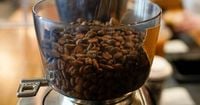It’s a tough time to be a coffee lover in America. Over the past year, the price of a daily cup of coffee has been climbing ever higher, with a complex blend of global politics, climate shocks, and economic forces brewing up a storm for both consumers and the industry at large. From the bustling cafes of Chicago to the sprawling coffee plantations of Brazil and Colombia, few have been spared the impact.
According to U.S. government figures, the average price for a pound of ground coffee reached $9.14 in September 2025—a 3% jump from August’s $8.87 and a staggering 41% increase compared to September of the previous year. The consumer price index, which tracks a broader range of coffee products including instant varieties, showed a 19% rise from September 2024, remaining flat compared to August 2025. As reported by the U.S. Labor Department, overall food prices for home and restaurant consumption rose 3% in September compared to a year earlier, reflecting the wider inflationary pressures facing American households.
So, what’s driving this relentless rise in coffee costs? The answer, as it turns out, is a potent mix of international trade disputes, climate change, and shifting economic realities. Since July 2025, the U.S. has imposed a 50% tariff on coffee imports from Brazil, the world’s largest coffee producer, which supplies nearly 40% of the global market and about 30% of the U.S. coffee supply. The Trump administration’s policy included a 40% tariff on Brazilian coffee layered atop an existing 10% tariff, as reported by multiple sources including Fortune and BBC. Brazilian producers, faced with the new costs, began withholding shipments to the U.S. while negotiating with American roasters over who would absorb the added expense, resulting in a tighter supply and even higher prices on American shelves.
Colombia, another coffee powerhouse responsible for 20% of U.S. imports, hasn’t been spared. The U.S. currently levies a 10% tariff on Colombian coffee, and President Donald Trump has threatened to raise those tariffs even higher and cut off U.S. aid to Colombia as part of a broader anti-drug campaign. Tensions escalated recently when Trump referred to Colombian President Gustavo Petro as “an illegal drug dealer” in a social media post. Petro’s response was swift: “Mr. Trump has slandered me and insulted Colombia.” These diplomatic strains have only added to the uncertainties facing coffee traders and buyers in both nations.
Vietnam, which provides 8% of the U.S. coffee market, has also been caught in the tariff crossfire, facing a 20% import duty since the summer of 2025. While President Trump announced in September that “unavailable natural resources” could be exempted from tariffs for countries with favorable trade agreements, coffee has yet to receive such an exemption. As a result, U.S. coffee importers find themselves paying more for beans from nearly every major supplier.
Meanwhile, the weather isn’t cooperating either. Brazil’s coffee-producing regions have suffered from relentless droughts every year since 2020, with 2025 bringing some of the worst conditions yet. The National Oceanic and Atmospheric Administration declared La Nina conditions earlier in October, stoking fears of further drought in Brazil. Though Brazil’s National Supply Company (Conab) expressed hope that recent rains might ease the stress on coffee plants, the overall outlook remains grim. According to studies cited by BBC, only half of today’s coffee-growing regions may remain suitable for coffee production by 2050 due to climate change. This looming threat has prompted researchers in Brazil to scout for new, more resilient growing areas with mild temperatures and access to irrigation.
The numbers tell the story: since August 2025, arabica coffee futures have soared nearly 40%, approaching record highs of $8,000 per ton, while robusta prices have climbed 37% to $4,540 per ton. The United Nations’ Food and Agriculture Organization reported that world coffee prices jumped nearly 40% in 2024 alone, a trend that shows little sign of slowing as both climate and trade pressures mount.
For small business owners and consumers, these global shifts have very real, local consequences. Nikki Bravo, co-owner of Momentum Coffee in Chicago, told Fortune that she recently raised prices by about 15% on lattes, cappuccinos, and other drinks at her four locations. The reason? She’s now paying 15% more for coffee beans—most of which she sources from Africa—and has started roasting more beans in-house to cut costs. But it’s not just the beans. “Other items also have gotten more expensive, such as cups and sleeves,” Bravo said, adding that Chicago’s minimum wage hike to $16.60 an hour on July 1, 2025, has further squeezed her margins. “At some point we just had to pass it along, we couldn’t continue to eat it.”
It’s not just independent cafes feeling the pinch. According to Toast, a restaurant management system, the average price of a regular coffee at U.S. restaurants in September was $3.54, up from $3.45 a year earlier. Stubbornly high inflation has made consumers more cautious, with some thinking twice before splurging on a takeout coffee.
With 99% of U.S. coffee being imported—outside of small-scale production in Hawaii and Puerto Rico—the country is especially vulnerable to global disruptions. The National Coffee Association, a trade group, has emphasized America’s reliance on imports and the risks inherent in current trade policies.
Not everyone is content to let these trends continue unchecked. In September 2025, a bipartisan group of U.S. House members introduced a bill to repeal all tariffs on coffee. “We only produce 1% of the coffee that Americans consume. It’s one of the best examples of Trump’s blanket tariffs making no economic sense,” said U.S. Rep. Ro Khanna, a California Democrat, who co-sponsored the bill with Nebraska Republican Don Bacon. Bacon explained his interest in the issue: “I hope the president and Congress see the positive benefit of removing this tariff on everyday Americans.” He also stressed that he’s “not a fan of tariffs and thinks Congress—not the president—has the power to levy them.”
As lawmakers debate the future of coffee tariffs, producers and researchers are racing to adapt to the changing climate and market. In Brazil, efforts are underway to zone new coffee-growing areas that offer better conditions for the crop, whether through milder temperatures, more reliable rainfall, or improved irrigation. Meanwhile, scientists around the world are developing new coffee varieties that can better withstand heat and drought, hoping to secure the future of the beloved beverage.
For now, though, coffee drinkers in the U.S. are left to watch prices rise and wonder when—if ever—the tide will turn. Until then, each cup carries with it not just a shot of caffeine, but a taste of the world’s shifting economic and environmental fortunes.

